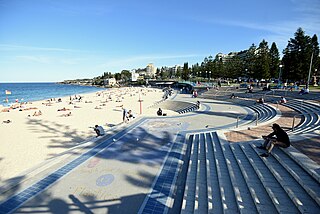
Coogee is a beachside suburb in the Eastern Suburbs of Sydney, in the City of Randwick. Coogee is located 8 kilometres south-east of the Sydney central business district, in the state of New South Wales, Australia.
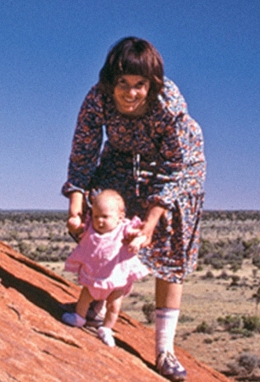
Azaria Chantel Loren Chamberlain was a nine-week-old Australian baby girl who was killed by a dingo on the night of the 17 August 1980 during a family camping trip to Uluru in the Northern Territory. Her body was never found. Her parents, Lindy and Michael Chamberlain, reported that she had been taken from their tent by a dingo. However, Lindy was tried for murder and spent more than three years in prison. Michael was also put in jail for some time. Lindy was released only after Azaria's jacket was found near a dingo lair and new inquests were opened. In 2012, 32 years after Azaria's death, the Chamberlains' version of events was officially supported by a coroner.
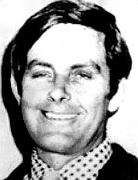
Donald Bruce Mackay was an Australian businessman and anti-drug campaigner. He disappeared in 1977, but his body has never been found. In 1986, James Bazley was convicted on his murder.
The backpacker murders were a spate of serial killings that took place in New South Wales, Australia, between 1989 and 1993, committed by Ivan Milat. The bodies of seven missing young people aged 19 to 22 were discovered partially buried in the Belanglo State Forest, 15 kilometres (9.3 mi) south-west of the New South Wales town of Berrima. Five of the victims were foreign backpackers and two were Australians from Melbourne. Milat was convicted of the murders on 27 July 1996 and was sentenced to seven consecutive life sentences, as well as 18 years without parole. He died in prison on 27 October 2019, having never confessed to the murders for which he was convicted.

Graeme Thorne was an Australian child who was kidnapped and murdered in 1960 for part of the money that his parents, Bazil and Freda, had won in an Opera House lottery. The crime, regarded as one of the most infamous in Australia's history, caused massive shock at the time and attracted huge public attention, and was the country's first well known kidnap for ransom. The police investigation that led to the capture and conviction of his murderer, an immigrant named Stephen Bradley, is often considered as pioneering, sophisticated, and the beginning of modern forensic investigation in Australia.

Greg Bird is an Australian former professional rugby league footballer who played in the 2000s and 2010s. He played as a stand-off, second-row or lock for Australia at international level.
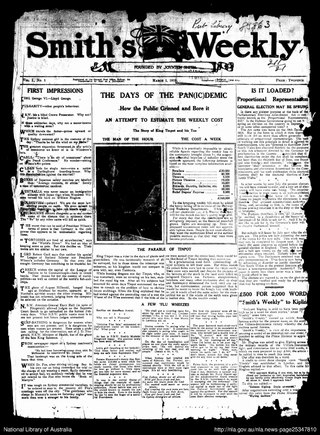
Smith's Weekly was an Australian tabloid newspaper published from 1919 to 1950. It was an independent weekly published in Sydney, but read all over Australia.

Sallie-Anne Huckstepp was an Australian writer, sex worker and whistleblower, who was the victim of a homicide. She came to attention in 1981 for speaking out about police corruption in Sydney, Australia. Huckstepp's murder remains unsolved.

Caroline Byrne, an Australian model, was found at the bottom of a cliff at The Gap in Sydney in the early hours of 8 June 1995. Her then boyfriend Gordon Eric Wood, who at the time of her death was a chauffeur and personal assistant to businessman Rene Rivkin, was convicted of her murder on 21 November 2008 and spent three years in Goulburn Correctional Centre. He was acquitted of the conviction in February 2012.
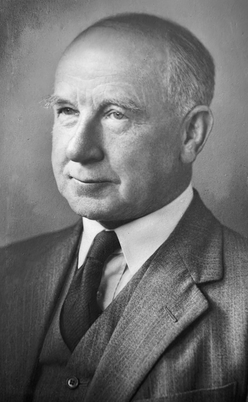
Sir Sydney Alfred Smith, was a forensic scientist, pathologist and one of the pre-eminent medico-legal specialists in the world. From 1928 to 1953, Smith was Regius Professor of Forensic Medicine at the University of Edinburgh, a well-known forensic department of that time. Smith's iconic 1959 autobiography Mostly Murder has run through many British and American editions and has been translated into several other languages.
Clive Raleigh Evatt was an Australian politician, barrister and raconteur. He was a member of the New South Wales Legislative Assembly from 1939 until 1959. At various times he sat as a member of the Industrial Labor Party, Labor Party and as an independent.
Keli Lane, a former Australian water polo player and teacher was convicted of the 1996 murder of her newborn baby, Tegan, and of three counts of making a false declaration. Lane is serving an 18-year prison sentence and will be eligible for parole on 12 May 2023, after serving a period of 13 years and five months in custody. On 18 April 2011, Lane's lawyers lodged an appeal against her conviction at the same time as a Sydney taxi driver alleged he saw Lane dispose of the child. Her final application for appeal was rejected by the High Court in August 2014.

Jaidyn Raymond Leskie was the Australian child of Bilynda Murphy and Brett Leskie, kidnapped and murdered in 1997. Leskie is believed to have died of head injuries. Despite intense public interest, several leads, and the arrest and trial of a prime suspect, Leskie's murder remains unsolved. Although the decision was made in 2002 not to hold an inquest into the toddler's death, the case remained in the news for several more years. An inquest was later held in 2006, implicating the mother's boyfriend, Greg Domaszewicz, who at the time of the kidnapping was babysitting the boy at his house at Newborough. The exact circumstances of Leskie's disappearance and death were never clear, and were complicated by vandalism at the house on the evening of the toddler's disappearance; several false tips and pranks about the boy's fate; and the body not being discovered until six months later.

William Joseph Hollebone, known informally as 'Joey' Hollebone, was a notorious and violent member of the criminal underworld, based in the inter-city suburbs of Sydney, Australia. Hollebone began serving a decade-long sentence for manslaughter in 1935, during which he met 'Chow' Hayes. From the mid-1940s to the mid-1950s Hollebone and Hayes were the best-known and feared of Sydney's criminal gunmen, with newspapers regularly reporting on their nefarious activities.
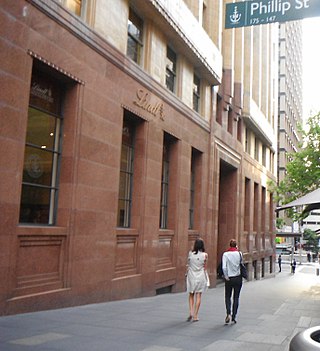
The Lindt Café siege was a terrorist attack that occurred on 15–16 December 2014 when a lone gunman, Man Haron Monis, held hostage ten customers and eight employees of a Lindt Chocolate Café in the APA Building in Martin Place, Sydney, Australia.
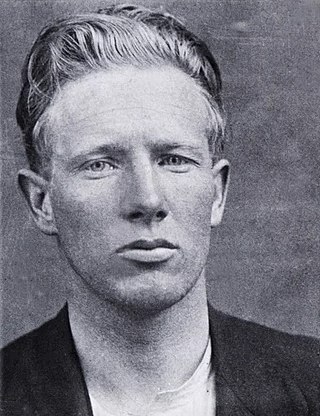
John Daniel 'Snowy' Cutmore, was a notorious and brutal Australian criminal, well-known in the criminal underworld of both Melbourne and Sydney during the inter-war years until his violent death in 1927. Cutmore was raised in inner-city Melbourne and was a prominent member of the Fitzroy Push, a lawless gang involved in prostitution, sly-grog and violence. Throughout his criminal career Cutmore displayed a willingness to relocate to another state to evade police attention, often travelling between Melbourne and Sydney. For a short period from late 1926 he was a member of Norman Bruhn's criminal gang in Sydney, attributed as Australia’s first 'razor gang' at the beginning of a period of gang violence in Sydney in the late-1920s known as the 'razor gang wars'. Cutmore was shot and killed in his mother's home in Carlton in October 1927, in an underworld gunfight that also resulted in the death of his rival, 'Squizzy' Taylor.

The Old Coroner's Court, The Rocks are heritage-listed shops and the site of the former The Rocks Visitors Centre, a former morgue, the former Coroner's Court of New South Wales and offices located at 102-104 George Street, in the inner city Sydney suburb of The Rocks in the City of Sydney local government area of New South Wales, Australia. It was designed by Walter Liberty Vernon and built from 1906 to 1908. It is also known as Coroner's Court (former) - Shops & offices, Coroners Court / City Morgue and shops and offices. The property is owned by Property NSW, an agency of the Government of New South Wales. It was added to the New South Wales State Heritage Register on 10 May 2002.
"The Grey Nurse Said Nothing" is a television play episode from the Australian television series The General Motors Hour. It was produced and directed by David Cahill. It was made by Channel Seven who later called "the most ambitious dramatic production ever attempted in Australia... [written by] one of the world's foremost authors of television plays and the cast is Ihe largest ever assembled for an Australian television dramatic production.... the greatest care has been taken to achieve the maximum possible standard in the production of the play which covered a total period of approximately eight weeks." The episode aired on 28 May 1960 in Sydney and Melbourne, and on 11 June 1960 in Brisbane.
Mostly Murder is the 1959 autobiography of forensic pathologist Sir Sydney Smith.













